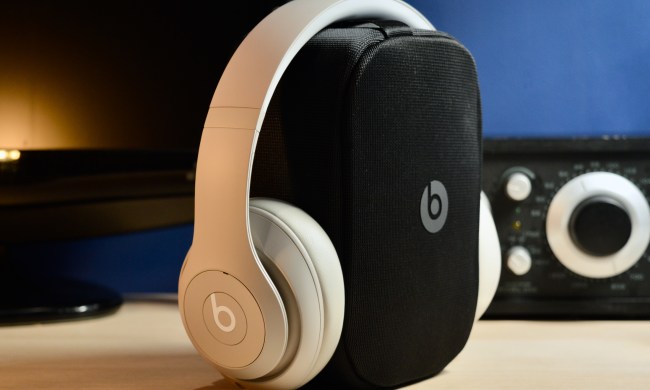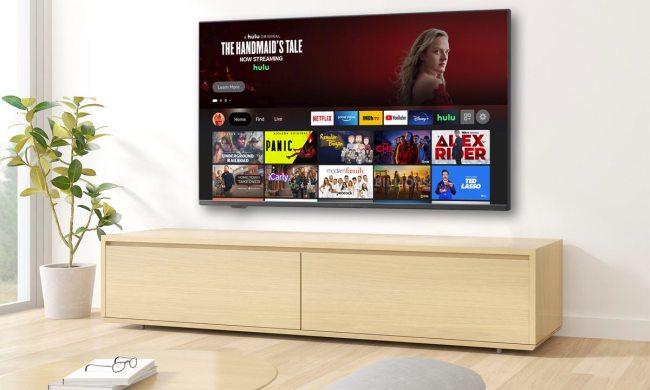
“It may not be backpack-friendly, but the Skullcandy Barrel is a loud, affordable Bluetooth boombox that can rock any party.”
- Great sound quality for price
- 60-watt power
- Stereo sound
- Aux input
- Physical controls
- No companion app
- Bass boost could be more powerful
- LED lightshow is meh
If you’re looking for an affordable, room-filling boombox that you can throw in the car and share between your home, cottage, or anywhere you don’t have to lug it too far, then the Skullcandy Barrel might just be the perfect Bluetooth speaker.
For an affordable $180, this beast of a speaker from the lifestyle audio brand known for its youth-targeted budget headphones has a lot going for it, but my expectations were, admittedly, a bit low going in. However, the Barrel’s big volume, clean and clear sound, and no-nonsense design and operation won me over in the end. It also has some tricks up its sleeve that you don’t see in a some comparable Bluetooth speakers. Here’s what I liked and didn’t like about the Skullcandy Barrel Bluetooth speaker.
Big-barrel design

If you’re familiar with other boombox-style Bluetooth speakers such as Soundcore’s $180 Motion Boom Plus or Tribit’s $200 StormBox Blast, then the Barrel isn’t going to be a big surprise. That said, it is quite a bit bigger, its sleek zeppelin shape and bright orange side-firing passive woofers do look unique, and its sturdy handle drives the boombox aesthetic home.
Available in two colors — black and a grayish color that Skullcandy calls Bone — its top, sides, and handle are made from a rock-hard plastic. The front and rear grilles are covered in a handsome woven fabric that is also supported from behind by what appears to be a honeycomb plastic layer that’s quite sturdy.
The holes in this honeycomb let the Barrel’s 60-watt output blast stereo sound from its front-facing single 6.5-inch woofer and dual 2.5-inch tweeters. And additional holes on the backside allow sound to radiate somewhat through the rear of the Barrel as well.
- 1. Side-firing passive bass radiators.
- 2. Adjustable sturdy shoulder strap.
- 3. Strong metal carabiners.
At a substantial 12 pounds, the 12-inch by 22-inch by 10-inch boombox isn’t exactly made for shoving in a backpack for camping trips or bike rides to the park. And that’s just fine, there are dozens of compact portable Bluetooth speakers out there for that. But considering the Barrel’s girth, it’s actually pretty portable if you don’t plan on carrying it too far (from the car to the pool party is perfect) thanks to its strong nylon strap that can be slung over your shoulder. The strap is securely fastened with high-quality metal carabiners, and my eagle-eyed colleague Simon Cohen pointed out that the buckle doubles as a bottle opener!
The Barrel features a mediocre 12-hour battery (compared to the StormBox’s 30 hours and the Boom Plus’s 20 hours), but I don’t imagine many people will be lugging this big boy too far from an outlet. Sadly, however, the included AC adapter is big and the speaker doesn’t support charging with a USB cable.

The last design feature to mention is the Barrel’s IPX5 rating, which means that the speaker isn’t waterproof (so don’t drop it in the pool), but it will withstand splashes and rain should a storm roll in during your party. Oh, and the “X” in the IP rating means that it hasn’t received a rating for dust resistance, so you should probably keep it out of the sand on the beach to err on the safe side.
Buttons and controls

On the top surface of the speaker, it’s nice to see a variety of physical buttons that make it easy to control most functions without having to reach for your phone. Cleverly, most of its six rubber-covered buttons serve multiple functions — you just need to get used to them and you’ll be flying.
Starting from the left, you have the LED light-change button, which changes of the colors and patterns of the light strip running across the front top of the speaker. Although a bit basic, the “light show” adds a bit of fun with its music-synced pulsing and movement that brings a bit of Cylon or K.I.T.T. from Knight Rider charm.
The Bluetooth button is next, and it gets the speaker easily paired by holding it down for a couple of seconds. The volume-down and volume-up buttons double as next/previous rack buttons when held down (in my test, though, this didn’t work with the Qobuz desktop app). And when you hold them both down together, a voice prompt lets you know the battery percentage (it’s also indicated by the four LED dots above the line of buttons).
The all-important play button not only pauses/plays when pressed, but activates the Barrel’s bass boost (and stays lit) when held. More on the bass boost in the performance section below.
The last button on the right is for power, which also activates the true wireless stereo (TWS) pairing for connecting another Barrel as a stereo pair. Holding the “play” and “+” buttons simultaneously lets you connect up to 99 other Skullcandy speakers (not in stereo) via the SKDY Multi-link feature. I was only sent a single Barrel, so I wasn’t able to try either of those features out.
Skullcandy does not support any of its speakers with a companion app, which means there’s no additional control over features like EQ, the LEDs, or connectivity. But honestly, while some EQ control would have been nice when using apps like Qobuz and Tidal that don’t have any built-in, I liked being able to control many of the Barrel’s functions on the device itself.
Inputs and connectivity

On the back of the Barrel, safely hidden behind a snugly fitting rubber panel, you’ll find the power input, two USB ports, and a 3.5mm Aux-in for connecting external devices such as computers, CD players, and smartphones (with the required adapters or DAC).
The USB-C port is solely for charging your devices, while the USB-A port does that, too, but also acts as an audio input, should you have a thumb drive full of music to plug in. Connecting a thumb drive is supposed to take priority over any Bluetooth connection, but in my tests, the Barrel kept cutting off the music to look for a Bluetooth connection. I’ve asked Skullcandy if this is a bug and will update this article when I hear back.

The Barrel features Bluetooth 5.3 connectivity and has a range of up to 10 meters. Two devices can be connected together, but only one can play at a time, which isn’t really a big deal, though you and your friends are going to have to learn how to take turns. The supported Bluetooth codec is also SBC, which sounds good, but AAC or something a bit better would have been nice.
Sound and performance

Don’t let straight specs lead you astray. The Soundcore Motion Boom Plus and the Tribit StormBox both outpower the Barrel at 80 watts and 90 watts, respectively, but the Barrel’s 60 watts did a pretty good job at blowing (what’s left of my) hair back. With more than enough volume to fill even large rooms, the Barrel’s sound maintains clarity even in the upper 20% of its full volume. As I mentioned in the intro, I was not expecting this level of fidelity out of a Skullcandy speaker, and the Barrel’s versatility and dynamics, no matter the kind of music I tossed at it, impressed me.
For most of my testing, I ran Spotify through either my Bluetooth-connected iPhone or the Spotify desktop app from my laptop, with no EQ settings applied. I also connected my iPhone to the Barrel’s Aux input with a lightning-to-3.5mm adapter and played tracks from Qobuz, with good results across the board.
Starting with the bass test, I can report that the Barrel has it where it counts with big, punchy, and well-controlled low end across all kinds of music styles. I will point out here that the Barrel’s “Bass Boost” should just be activated at all times. Without it, everything sounds much less full. Unless you hate bass, just turn it on and leave it alone.

Speaking of bass, Dead Prez’s bass-heavy track Hip-Hop took me by surprise after I did my peak volume testing (I forgot the volume was almost at full). When that electronic bassline kicked in, it was a swift punch in the gut. The kick drum intro of Nine Inch Nails’ Closer was as punchy as it should be, and when it really gets moving at around the 4:26 mark, with its full range of frequencies firing off — keys, distorted guitars, and tweaky samples — the Barrel pulls it off with balance and authority. My go-to Billie Eilish tracks, with their saturated bass tones, also hold up.
The mids and highs coming out of the Barrel sound balanced and clearly defined, although they do get a bit harsher after prolonged listening at higher volumes. But that one I’ll chalk up to a reviewer’s occupational hazard — no one should be listening to a speaker at that volume, for that long, sitting that close.
Radiohead’s Let Down, with its playful guitar arpeggios, sounds as it should — shimmering and smooth at the same time. And Thom Yorke’s vocals and harmonies are clear and sonically rich. If vocals are your thing, Sweet Dreams by the Eurythmics sounds excellent on the Barrel, too. Its iconic buzzing synth intro is great, but the real showstopper is Annie Lennox’s voice, even when she wails those atmospheric falsettos that come from off in the distance.
Overall, for its affordable price, there’s nothing to complain about with the sound coming out of the Skullcandy Barrel. With no Skullcandy companion app to adjust EQ settings, the “custom-tuned” Barrel has a well-balanced sound signature that’s good for all kinds of music. All that is to say that, unlike other speakers I’ve tested that required heavy EQ tweaking, the Barrel happily doesn’t need it. But if you must fine-tune, just keep in mind that you’ll have to do it with a streaming app like Spotify or Apple Music.







